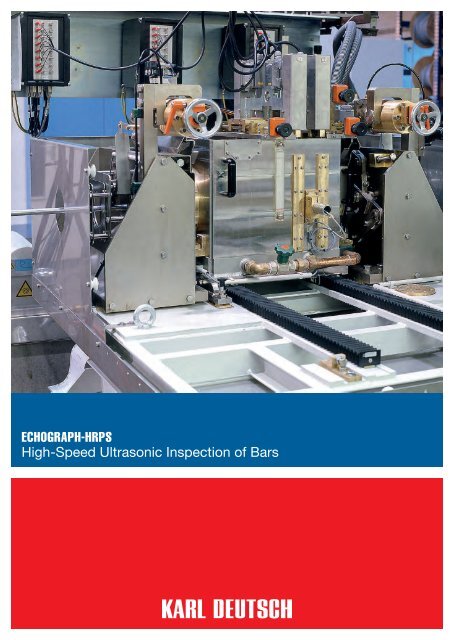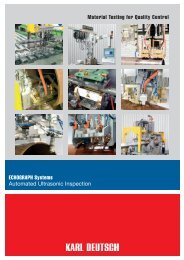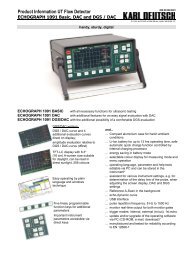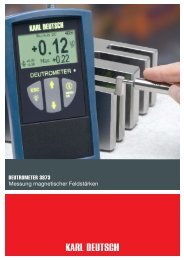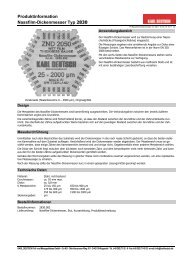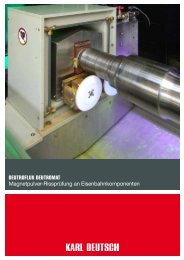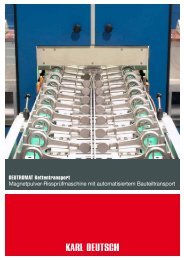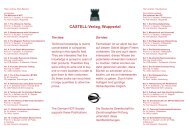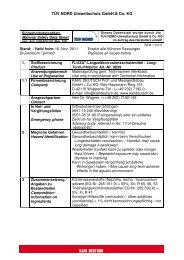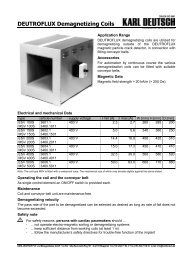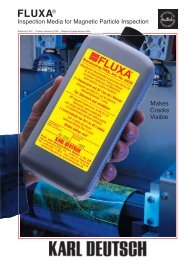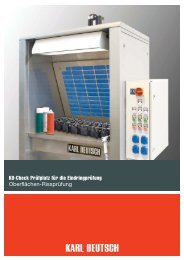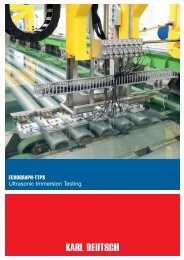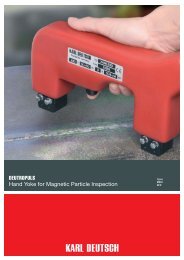ECHOGRAPH-HRPS High-Speed Ultrasonic ... - Karl Deutsch
ECHOGRAPH-HRPS High-Speed Ultrasonic ... - Karl Deutsch
ECHOGRAPH-HRPS High-Speed Ultrasonic ... - Karl Deutsch
Create successful ePaper yourself
Turn your PDF publications into a flip-book with our unique Google optimized e-Paper software.
<strong>ECHOGRAPH</strong>-<strong>HRPS</strong><br />
<strong>High</strong>-<strong>Speed</strong> <strong>Ultrasonic</strong> Inspection of Bars
<strong>ECHOGRAPH</strong>-<strong>HRPS</strong><br />
<strong>High</strong>-<strong>Speed</strong> <strong>Ultrasonic</strong> Inspection of Bars<br />
Principle of closing mechanics of test<br />
chamber: a) opened test chamber while<br />
bar is tested, b) bar is leaving the test<br />
chamber and one side of chamber is<br />
already closed. The ultrasonic probes<br />
are active as long as the bar is within the<br />
ultrasonic beams. The electronic test<br />
enable signals (to activate the probes)<br />
are programmable to reach the shortest<br />
possible untested ends.<br />
Water-filled test chamber in opened and closed condition<br />
<strong>High</strong>-<strong>Speed</strong> <strong>Ultrasonic</strong> Inspection of<br />
Bars<br />
KARL DEUTSCH has developed ultrasonic<br />
testing equipment since 1951 and shipped<br />
the first inspection system for billet inspection<br />
in 1965. Many improvements for the<br />
<strong>ECHOGRAPH</strong>-electronics, the robust testing<br />
mechanics and the ultrasonic probes<br />
have led to our current state-of-the-art.<br />
KARL DEUTSCH maintains a strict quality<br />
management system according to<br />
DIN EN ISO 9001.<br />
At the moment, a bar diameter range from<br />
7 mm to 93 mm can be tested with the<br />
<strong>ECHOGRAPH</strong>-<strong>HRPS</strong> system. The testing<br />
system works with the immersion technique,<br />
meaning that the part of the bar to<br />
be inspected is fully immersed in water.<br />
The system uses a water chamber and<br />
several probe cassettes on which the ultrasonic<br />
probes are mounted around the<br />
circumference of the bar. No mechanical<br />
rotation is employed in this concept,<br />
therefore avoiding mechanical wear of the<br />
testing mechanics and the untested zones<br />
which might occur with helical test traces<br />
and high testing speeds.<br />
A key feature of the testing concept with<br />
stationary probes is the high inspection<br />
speed of up to 2 m/s and the robust mechanics<br />
which shows very little wear since<br />
no rotational components are used. The ultrasonic<br />
pulse density in the transportation<br />
direction is high enough so that overlap in<br />
the transportation direction is produced.<br />
Therefore, another important feature of the<br />
system is the detection of short defects.<br />
Most defects show a longitudinal geometry<br />
due to the rolling process. The determination<br />
of length for longitudinal defects<br />
is an easy task with stationary probes. The<br />
defect is always found by the same probe.<br />
Counting the pulses above the calibrated<br />
amplitude threshold and knowing the<br />
pulse density quickly produces the defect<br />
length. To avoid pseudo indications, e.g.<br />
from surface scratches, a pulse counter<br />
can be set to a value which is suitable<br />
for the bar quality. A minimum number of<br />
ultrasonic pulses exceeding the preset<br />
threshold is required before the system<br />
alarm becomes active. Again this feature<br />
can be used to adjust the minimum flaw<br />
length which should be detected with the<br />
system.
<strong>ECHOGRAPH</strong>-<strong>HRPS</strong><br />
<strong>High</strong>-<strong>Speed</strong> <strong>Ultrasonic</strong> Inspection of Bars<br />
System calibration by means of short bar carrying artificial defects.<br />
The bar is rotated so the defect will pass each ultrasonic<br />
probe. Afterwards, the automated sensitivity adjustment equalizes<br />
the sensitivity of all probes. For the calibration process, the test<br />
chamber is moved into calibration position (offline).<br />
Special line-focussed probes for angular incidence in different<br />
sizes to test the respective bar diameters: Each probe covers<br />
30 degrees of the bar surface – independently from the bar<br />
diameter.<br />
Since invention of the <strong>HRPS</strong>-setup, many probe configurations<br />
have been realized. For bar testing, a setup with 16 angle beam<br />
probes and 5 straight beam probes has been proven to be a reliable<br />
setup for 100% cross sectional coverage of the bars. The<br />
more probes are used, the higher is the probability of detection<br />
(POD) also of oblique and crack-type defects.<br />
Test cassette with ring of ultrasonic probes: Angle beam<br />
probes are used to detect surface defects while straight beam<br />
probes are used to detect core defects.The testing angle of all<br />
angle beam probes is centrally adjusted by the spindle and the<br />
orange dial.
<strong>ECHOGRAPH</strong>-<strong>HRPS</strong><br />
<strong>High</strong>-<strong>Speed</strong> <strong>Ultrasonic</strong> Inspection of Bars<br />
Similar test results can be obtained by using ultrasonic phased arrays. The bar is entirely enclosed by an annular ring array. The<br />
phased array technique can then be used to produce straight beam testing (yellow beam) or angle beam testing (green beam). The<br />
advantage of a phased array setup is the fast change-over time to different specimen dimensions and the possibility to adjust all test<br />
parameters electronically. On the other hand, this technique requires many electronic testing channels and extensive probe arrays.<br />
Specimens<br />
Bars<br />
Diameter range (D) 10 mm - 90 mm<br />
Specimen ends machined, no burr<br />
Straightness deviation max. 1 mm/m<br />
Surface condition machined (desirable)<br />
Ovality max. 1% of D<br />
KARL DEUTSCH Pruef- und Messgeraetebau GmbH + Co KG<br />
Otto-Hausmann-Ring 101 · 42115 Wuppertal · Germany<br />
Phone (+49 -202) 7192-0 · Fax (+49 -202) 7149 32<br />
info@karldeutsch.de · www.karldeutsch.de<br />
DIN EN ISO<br />
9001<br />
certified<br />
PI <strong>HRPS</strong> e 2012 03 • Subject to change without notice • Printed in Germany


